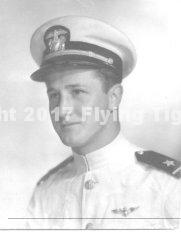| Last Name: |
|
 |
| First Name: |
|
| Nickname: |
|
| Born/Died |
|
| Hometown: |
|
| Squadron: |
|
| Rank: |
|
| Victories |
|
| Decorations: |
| Distinguished Flying Cross, Bronze Star, Chinese Order of the Cloud Banner, Prisoner of War Medal, WWII Victory Medal, American Defense Medal, American Campaign Medal, Asiatic Pacific Campaign, Presidential Unit Citation. |
|
| Pre AVG: |
| 10th of 12 children born to Mr. & Mrs. George Bishop, dairy farmers of DeKalb Junction, NY. Dean High School, Gouverneur, NY 1934; Oklahoma Military Academy, Claremore, OK 1935-1937; Flight School, Pensacola Naval Air Station 1937-1938; USS West Virginia 1938-1940; Flight Instructor, Pensacola NAS 1940-1941. |
|
| AVG Service: |
| Volunteered 8/30//41 and arrived in Rangoon, Burma 11/13/41 aboard the Dutch ship Boschfontein with Charles Bond, Dick Rossi, et al. His first daughter was born 11 days after he reached Rangoon. first action was 12/25/41 with 3rd Squadron over Rangoon. Began as Flight Leader and was promoted to Vice Squadron Leader for bravery in raid on Japanese military airfield at Hanoi on 5/10/42. Also participated in many other actions including Loiwing and the Salween River Gorge. Spent most of March 1942 leading trip to Cairo to ferry new P-40E equipment to Kunming. Credited with 5.2 confirmed victories. While leading a mission over Lao Kai, French Indochina on May 17, 1942, his plane was damaged, either by enemy ground fire or a bomb exploding prematurely. He was forced to bail out and was picked up by the Vichy French. Claire Chennault offered a large ransom for the return of Bishop, with the approval of Chiang kai-Shek, but he Japanese took custody. Their Kempetai military police held him as a political prisoner in Hanoi, Saigon, Haiphong, Canton and Shanghai for nearly a year. |
|
| Post AVG, WWII: |
| Lew Bishop was a prisoner of the Japanese from 1942-45. After almost dying by mistreatment, starvation and disease while a Kempetai military prisoner at the notorious Bridgehouse jail in Shanghai, he was transferred to the Kiangwan POW camp and spent two more years recovering. With four Marines from Kiangwan camp, he escaped from a moving POW train on May 10, 1945 while the camp was being transported north to Manchuria. The group of 5 made their way nearly 2,000 miles back to Kunming on June 30, 1945, requiring over 40 days of overland travel with the assistance of Chinese Communists and Nationalists and then two days flying from an OSS airfield behind enemy lines. He gave debriefing to General Chennault and Army intelligence before reaching the US on July 9, 1945 |
|
| Post War Career: |
In the fall of 1945 he returned to the Naval Reserve per the CAMCO contract agreement. He requested and was granted inactive duty status on March 1, 1946. After a divorce, he returned to China to fly cargo missions with China National Aviation Corp. (CNAC). He found that stresses from POW confinement precluded his assignment of “flying the hump” over the Himalaya mountain range and he returned to the US. In 1946 he applied for a Regular Navy commission and returned to active duty at the rank of Commander. After a flight refresher course at Jacksonville NAS, he was subsequently named commander of Squadron VF-7, Quonset Point, RI. In November, 1947 he participated in extended sea maneuvers on the USS Leyte in early 1948 where he earned outstanding Squadron recognition.
Due to the stresses and conditions of his Japanese imprisonment as well as other pressures he was hospitalized and eventually received a total disability retirement from the Navy in 1948. He lived in retirement until his death on November 1, 1987.
Lew Bishop left a daughter from his first marriage, Shiela Bishop Irwin and three grandsons, and a daughter, Dianne Bishop Taylor and a grandson from a second marriage.
– Contributed by Shiela Bishop Irwin |
|

